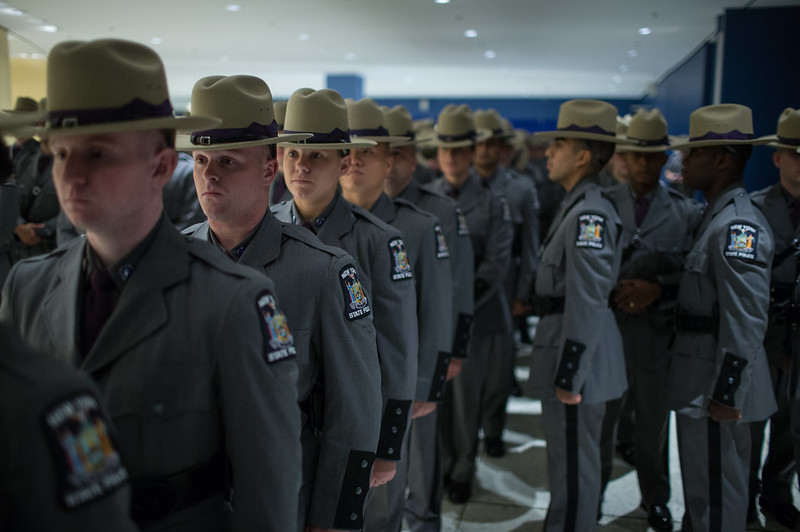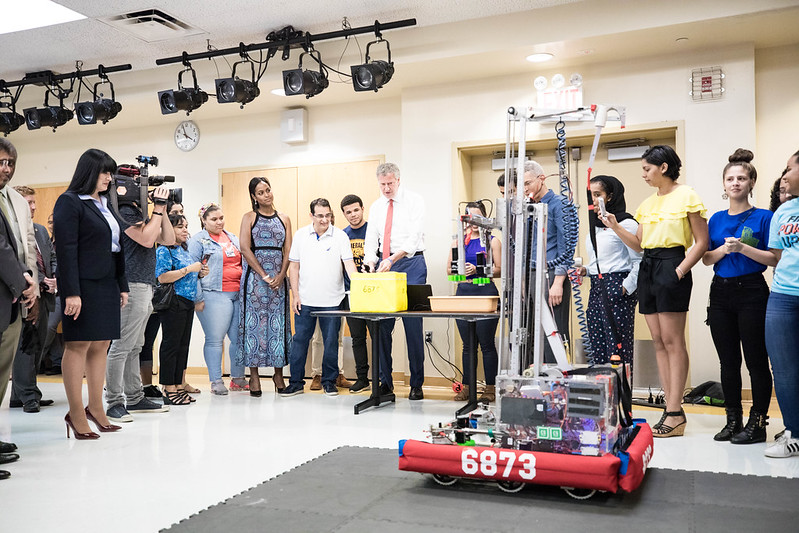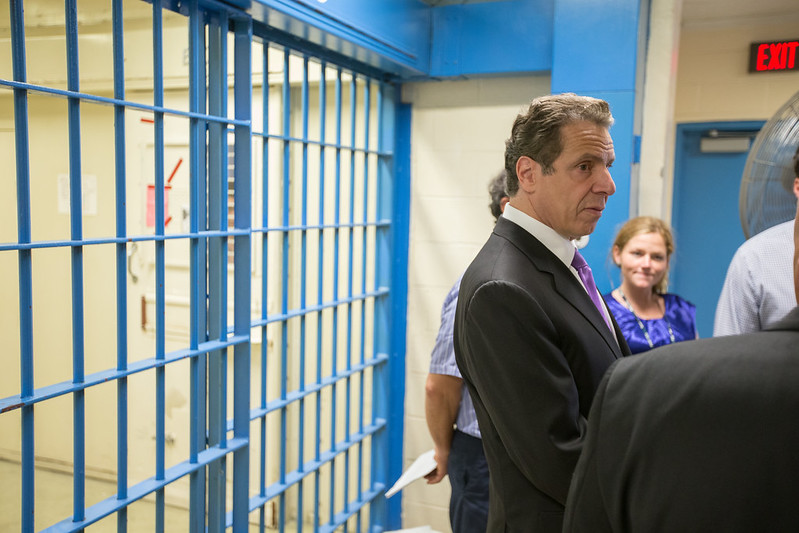Surveillance and the City: Security Theater’s Steep Price

(photo: Governor's Office)
The fear is real. Like so many Jewish New Yorkers, I felt that pang of dread and revulsion when I heard about the deadly shooting at a kosher market in Jersey City. And, as the seemingly endless list of attacks grew, so did my concern about how our community was being targeted. And then, as we prepared to welcome a new decade, this age old bigotry took terrifying new form in the Hanukkah party attack in Monsey.
Of course, after this onslaught of heartbreak, people are afraid. The fear they feel is real. But the solutions they are being offered are not.
More police, longer jail terms, reversing bail reform, and even calling out the national guard. It’s unclear what’s more absurd: the number of proposals being made or the content of what’s put forward. Friday, the list grew to include 100 new security cameras in predominantly Hasidic areas of Brooklyn courtesy of Mayor de Blasio.
Some of these come from concerned New Yorkers who don’t know where else to turn. But others come from officials who should know better, those trying to exploit our grief and fear to get their moment in the spotlight and push forward their ideological agenda.
One of the most enraging stunts is the persistent attack on last year’s hard-won bail reforms. Less than a week after these common-sense changes went into effect, largely eliminating a cash bail system that treated poverty as a public safety threat, lawmakers put forward the idea of a new bail exception for hate crimes.
Set aside the fact that none of these attacks would have been stopped by such a measure, we’re still left with the rationale of a justice system that is designed to presume some defendants guilty before their day in court.
Perhaps the most chilling suggestion came from State Senator Simcha Felder, Assemblyman Simcha Eichenstein, and City Council Members Chaim Deutsch and Kalman Yeger. Not only did the four elected officials ask for high-visibility policing of Jewish neighborhoods, but they even asked Governor Cuomo to call out the national guard. Are we really going to set-up Baghdad-style checkpoints and blast walls in Bed Stuy? The absurd idea would almost be funny if it weren’t so dangerous.
Let’s be clear: we make bad policies in times of fear. In the 1990s, our fear of crime propelled draconian policies that stripped a generation of New Yorkers (and other Americans) of color of their freedom. After 9/11, our rage and terror blundered us into quagmires half a world away, while propelling outright religious profiling here at home. When we are scared, when we are hurt, we ignore the costs of the security theater that we’re sold.
Like the snake oil elixirs of the 19th century, these cure-alls come at a steep price. Whether it’s the new officers or new surveillance tools, we are being asked to spend millions on measures that may not work at all. In exchange we’ll see cuts to programs that make a real difference in New Yorkers’ lives. It’s impossible to know what will bear the brunt of the ensuing offsets -- will the money comes from schools, transit, or some other vital service? But the heaviest price isn’t paid in dollars and cents, it’s the impact these policies will have on the countless New Yorkers who are wrongfully targeted and arrested as a result.
But our security culture will also take a toll on the Jewish Community. I know our families need to feel safe, but how we find that safety matters. I fear the emergence of fortress Judaism, a faith marked by fear of, and separation from, the outside world. When we isolate ourselves from our neighbors, when we view them as threats, it harms the very solidarity we need in order to overcome this moment.
Let’s be clear: no amount of policing will end anti-Semitism. You can’t stamp out a hateful ideology with a badge and a gun. Yes, those who commit hate crimes should be prosecuted, but that is not a scalable solution. A hate crime sentencing enhancement didn’t deter the couple that opened fire in Jersey City or the mentally-ill man who attacked the party in Monsey. More importantly, longer jail terms will do nothing to dissuade the next person in mental health crisis who fixates on this twisted ideology.
This doesn’t mean we can’t act, just the contrary. It means we need an immediate response, not from Albany or City Hall, but from each and every one of us. It means that we need more of the solidarity we saw Sunday, when thousands of New Yorkers of all faiths marched across the Brooklyn Bridge against hate.
It means we need the interfaith communities that bring New Yorkers of every background together to combat bias. That is the path out of this dark moment, not by building up walls, but by linking arms and standing together as one city.
***
Albert Fox Cahn is the founder and executive director of the Surveillance Technology Oversight Project (S.T.O.P.) at the Urban Justice Center, a New York-based civil rights and privacy group, and a fellow at the Engelberg Center for Innovation Law & Policy at N.Y.U. School of Law. He writes the monthly "Surveillance and the City" column for Gotham Gazette. On Twitter @FoxCahn & @STOPspyingNY.
***
Have an op-ed idea or submission for Gotham Gazette? Email This email address is being protected from spambots. You need JavaScript enabled to view it.
What the Future of Education Looks Like

(photo: Benjamin Kanter/Mayoral Photo Office)
Late last year, Mayor Bill de Blasio and City Schools Chancellor Richard Carranza proudly announced “record increases” in internet bandwidth in public school buildings – an important milestone because in a digital world, every school deserves good internet access.
But, the announcement invited more questions than it answered, especially in light of the Department of Education’s other recent announcement of planning to create or redesign 40 schools “of the future.”
What is a “school of the future”? If it’s just faster internet, new computers, and fresh branding, it’s not going to create the kind of opportunity or change the system needs. We need to think bigger if we’re serious about giving public school students a chance to compete in a digital world.
What new skills and knowledge will graduates need to find jobs in 10 years? What new kinds of literacy will they need to make sense of the world in 20 years? What social and moral education do kids need to live in a digital society?
If our schools can’t answer these questions, we’re making cosmetic changes to the same outdated model.
Take a recent report by Burning-Glass Technologies, a premier labor market analyst. Burning-Glass looked at millions of job postings and identified 14 “New Foundational Skills” that translate to more money and more opportunity in the digital economy. Specifically, they found that skills in data analysis, computer programming, creativity, critical thinking, and project management are now essential across most good jobs.
Yet, our schools today are not designed to teach, develop, or assess for most of these skills. Classrooms look nothing like the modern workplace, and the basic content required to graduate high school in New York State has barely changed in 50 years (though the state is finally starting down the long road to change these requirements).
School schedules are a good example. Right now, students learn in 45- or 60-minute lessons, “punching in and out” of subjects, often working and being graded independently. In today’s workforce, most good jobs don’t work on shift schedules and almost everyone works in teams.
Consider testing. So much of the debate revolves around whether or how often to test – not necessarily on what to test and why. How does the English Regents exam, a graduation requirement, assess writing? It asks kids to write a literary essay – an opening, a thesis, and a five-paragraph structure interpreting a novel. Good writing is critical for long-term success. But, when was the last time most of us wrote a literary essay at work?
As the founding principal of the Urban Assembly Charter School for Computer Science (Comp Sci High for short), we’re working to do things differently – what and how kids learn, develop in-demand skills, and generate a pipeline of tech talent in the Bronx. We’re attempting to build a school of the future, and we’re showing that schools can teach history and HTML, that we can focus on integers and internships.
We’re looking at trends in the labor market and in society and working backwards to redesign curricula. Policymakers and school designers should do the same.
First, we need to build in more flexibility. School isn’t a factory and kids aren’t identical cogs in a machine. Flexibility starts from both a curricular standpoint and a scheduling one. We must recognize that within a class of 30 high school students, kids will grasp concepts at different rates and have different interests. Consequently, learning in the classroom and course pathways in a school need to be more personalized. Why, exactly, does everyone still need to learn chemistry but not computing?
Instead, content and curriculum can and should be personalized using technological tools and creative scheduling.
Next, we need to redesign curricula with a focus on both skills and knowledge. Understanding how to work on a team, to delegate, to work collaboratively and independently, and solve open-ended problems – these are a few of the core skills that aren’t included in most academic standards or curricula.
We also need to modernize graduation requirements to align with preparedness for the labor market. If foundational skills – human skills, digital building block skills, and business processes – are valued by employers, then we need to rethink not just what we’re teaching but what we’re testing. School isn’t only about getting a job. But, that should be part of the promise we make to kids when we tell them to stay in school and work hard. And yet, right now we have many thousands of high school and college students graduating with few career prospects and a lot of debt.
We need a clearer relationship between what kids learn in school and what they might do afterward. That means rethinking what and how kids learn from top to bottom. Without that level of change, school really will become just an academic exercise.
***
David Noah is the Principal of Urban Assembly Charter School for Computer Science, the city’s first career and technical education charter school.
***
Have an op-ed idea or submission for Gotham Gazette? Email This email address is being protected from spambots. You need JavaScript enabled to view it.
Cuomo's Clemency and Cruelty of False Hope

(photo: Governor's Office)
In 2015, New York Governor Andrew Cuomo announced a project to provide pro bono legal services to prisoners seeking clemency. The governor explained that this was “a critical step toward a more just, more fair, and more compassionate New York,” and that he sought to “identify those deserving of a second chance and to help ensure that clemency is a more accessible and tangible reality.”
Two years later, the governor re-emphasized his interest in clemency via a press release stating that “Family members of individuals serving prison sentences are encouraged to apply for clemency on behalf of their family member.”
This expressed interest in clemency, more specifically clemency in the form of a commutation of sentence, reverberated across New York’s patchwork of 50 state prisons. Men and women serving lengthy sentences with no chance of ever obtaining their freedom now had hope. People who spent their time wasting away in their cells began to re-engage with programs. Family visits reflected renewed promise of the possibility of unification beyond the prison walls.
In short order, CUNY Law School’s clemency project received more than 1,800 requests for help with clemency applications.
Yet not a single person had their sentence commuted in 2019 despite an abundance of robust and meritorious applications. Then on Friday, January 3, 2020 at 6:15 p.m., an auspicious time for any gubernatorial announcement, Governor Cuomo revealed that clemency requests for commutations had been granted to two people. Two people out of thousands of applicants.
Apparently, the promise of making clemency an “accessible and tangible reality” was nothing more than a cruel, soul-crushing hoax.
Placing the governor’s reluctance to commute sentences in context, consider that last November, Governor Kevin Stitt of Oklahoma, a Republican, signed off on commutations of sentences for 527 people. Earlier in the year, Governor Gavin Newsome of California, a Democrat, commuted the sentences for 21 people. In 2017 and 2018, then-California Governor Jerry Brown issued 49 commutations.
To be clear, the blame for the crying need for clemency -- for deserving people to get out from under massively long sentences -- lays at the feet of prosecutors and judges. Sentences like fifty, sixty, and seventy-five years to life, that foreclosed any chance of redemption, were routinely handed down in the 1970s, 1980s, and 1990s. As a result, there are almost 9,000 people serving life terms in New York prisons. Many of those people will die before ever being eligible to see a parole board.
The recognition that prosecutors and judges are the primary cause of death by incarceration sentences is precisely the reason that the unfettered power to grant clemency is enshrined in the state and the federal constitutions; all it takes for the governor to give someone a second chance is the stroke of his pen.
The executive’s power to grant clemency has deep historical roots dating back to biblical times when Pontius Pilate pardoned Barabbas instead of Christ. In British tradition, the monarch had the royal prerogative to grant pardons. Alexander Hamilton wrote in the Federalist Papers that in order to serve its humanitarian purpose, “the benign prerogative of pardoning should be as
little as possible fettered,” and that without the power to pardon, “justice would wear a countenance too sanguinary and cruel.” Hamilton argued that clemency allowed the executive to be a "dispenser of the mercy of the government."
In present terms, clemency is the most readily available means to repair the nationally acknowledged crisis of mass incarceration that has devastated communities of color. Mass incarceration is not just about unnecessarily incarcerating masses of people, but rather unnecessarily keeping masses of people in prison for decades. Clemency is a means to address that brutal reality.
Furthermore, while clemency is usually cast as an act of mercy, we all stand to gain when clemency is granted to deserving people. They are reunited with their families. They care for aging parents. They are the true credible messengers who mentor young people who might be on the wrong path. They have jobs and contribute to the economy. And the taxpayer no longer needs to pay for the medical care required for older people in prison, among other costs. Liberal application of clemency makes us all safer and better.
Many of the men and women who submitted clemency applications based on renewed hope inspired by Governor Cuomo’s words are now saying that false hope is worse than no hope. The wife of one of those men put it best in a tweet: “My husband wrote that he, his good friends, and more than 100 others sat on the edge of their metal beds all month [of December] waiting...PLEASE recognize the strides these men have made and show them mercy and use your redeeming power as the leader of this state.”
While clemency is typically cast as an end of year event consistent with holiday sentiments of mercy, charity, and forgiveness, surely there must be room for mercy, charity, and forgiveness more than once a year. And surely, there are more than two people among the 45,000 in New York State prisons who deserve the measure of mercy afforded by a sentence commutation.
***
Steven Zeidman is a professor of law at CUNY School of Law. On Twitter @SteveZeidman.
***
Have an op-ed idea or submission for Gotham Gazette? Email This email address is being protected from spambots. You need JavaScript enabled to view it.




